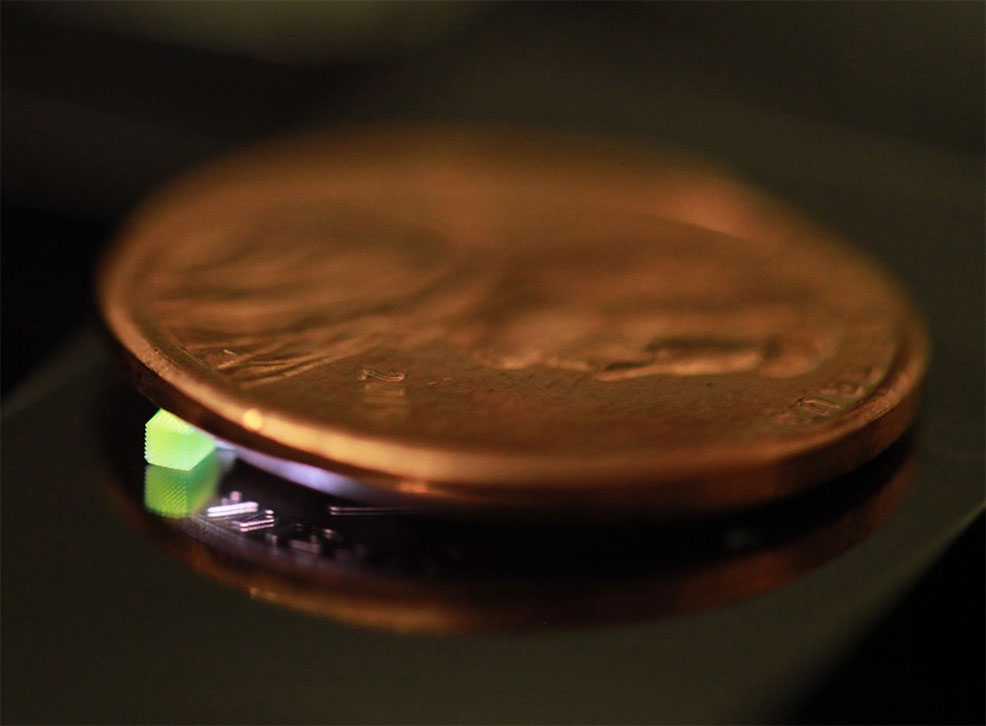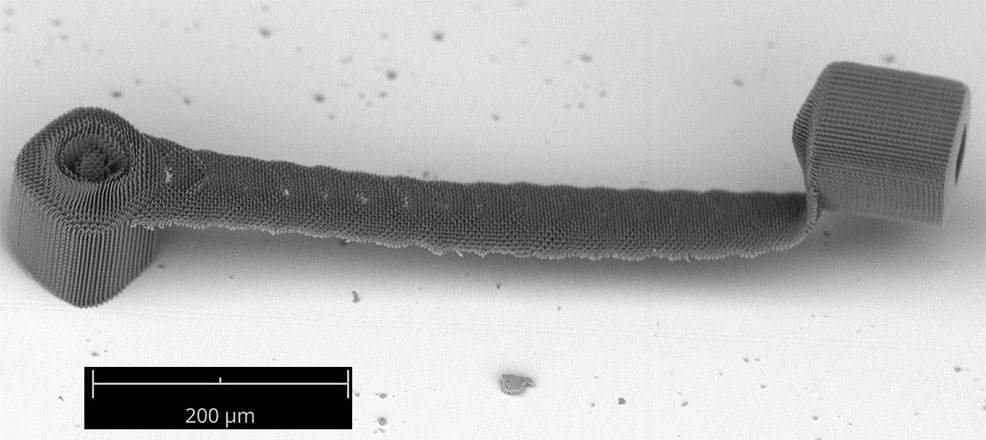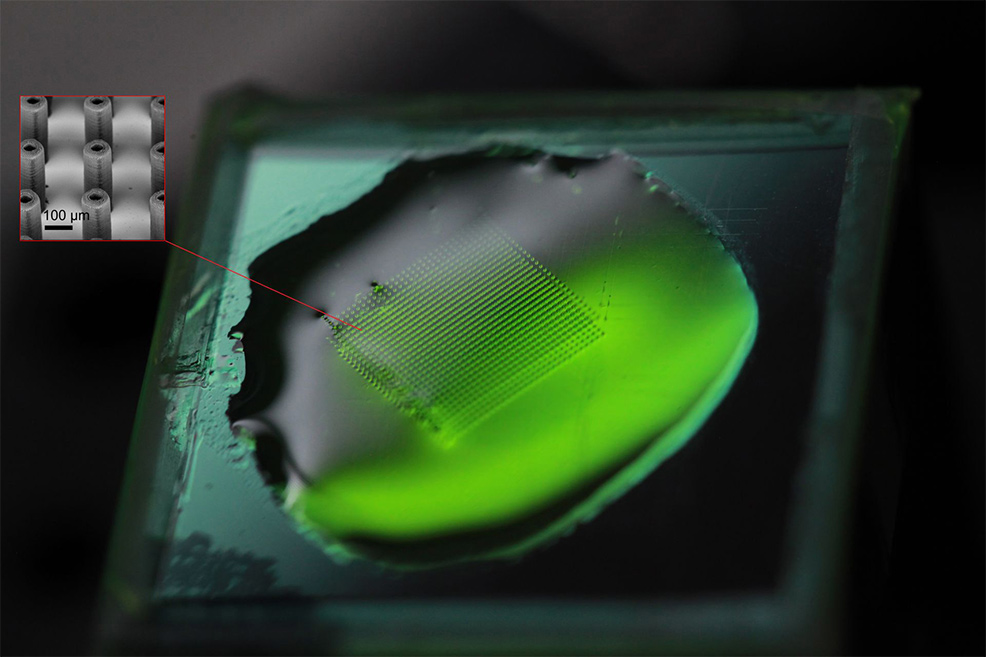
7th October 2019 Nanoscale 3D printing technique is 1,000 times faster Scientists report a new parallelised technique, known as femtosecond projection TPL (FP-TPL), which can 3D print nanoscale structures up to 1,000 times faster than conventional two-photon lithography (TPL).
Using a new time-based method to control light from an ultra-fast laser, researchers have developed a nanoscale 3D printing technique that can fabricate tiny structures a thousand times faster than conventional two-photon lithography (TPL) techniques, without sacrificing resolution. Despite the high throughput, the new parallelised technique – known as femtosecond projection TPL (FP-TPL) – produces depth resolution of 175 nanometres (nm), which is better than established methods and can fabricate structures with 90-degree overhangs that can't currently be made. The technique could lead to manufacturing-scale production of bioscaffolds, flexible electronics, electrochemical interfaces, micro-optics, mechanical and optical metamaterials, and other functional micro- and nanostructures. The breakthrough, reported in the journal Science, was achieved by researchers from Lawrence Livermore National Laboratory (LLNL) and the Chinese University of Hong Kong. Existing nanoscale additive manufacturing techniques use a single spot of high-intensity light – typically around 750 nanometres in diameter – to convert photopolymer materials from liquids to solids. Because the point must scan through the entire structure being fabricated, the existing TPL technique can require many hours to produce complex 3D structures, which limits its ability to be scaled up for practical applications. "Instead of using a single point of light, we project a million points simultaneously," said Sourabh Saha, the paper's lead and corresponding author, who is now an assistant professor in Mechanical Engineering at the Georgia Institute of Technology. "This scales up the process dramatically, because instead of working with a single point that has to be scanned to create the structure, we can use an entire plane of projected light. Instead of focusing a single point, we have an entire focused plane that can be patterned into arbitrary structures."
To create a million points, the researchers use a digital mask similar to those used in projectors to create images and videos. In this case, the mask controls a femtosecond laser to create the desired light pattern in the precursor liquid polymer material. The high-intensity light causes a polymerisation reaction that turns the liquid to solid, where desired, to create 3D structures. Each layer of the fabricated structure is formed by a 35-femtosecond burst of high-intensity light. The projector and mask are then used to create layer after layer until the entire structure is produced. The liquid polymer is then removed, leaving behind the solid. The FP-TPL technique allows the researchers to produce in eight minutes a structure that would take several hours with earlier processes. "The parallel two-photon system that has been developed is a breakthrough in nanoscale printing that will enable the remarkable performance in materials and structures at this size scale to be realised in usable components," said Chris Spadaccini, Director at the Centre for Engineered Materials, Manufacturing and Optimisation at LLNL. Unlike consumer 3D printing that uses particles sprayed onto a surface, the new technique goes deep into the liquid precursor, allowing fabrication of structures that could not be produced with surface fabrication alone. For instance, it can produce what Saha calls an "impossible bridge" with 90-degree overhangs and with more than a 1,000:1 aspect ratio of length to feature size.
"We can project the light to any depth that we want in the material, so we can make suspended 3D structures," said Saha. The researchers have printed suspended structures a millimetre long between bases that are smaller than 100 x 100 microns. The structure doesn't collapse while being fabricated because the liquid and solid are about the same density – and production happens so quickly that the liquid doesn't have time to be disturbed. Beyond bridges, the researchers made a variety of structures chosen to demonstrate the technique, including micro-pillars, cuboids, log-piles, wires and spirals. The researchers used conventional polymer precursors, but Saha believes the technique would also work for metals and ceramics that can be generated from precursor polymers. "The real application for this would be in industrial-scale production of small devices that may be integrated into larger products, such as components in smartphones," he said. "The next step is to demonstrate that we can print with other materials to expand the material palette." Research groups have been working for years to accelerate the two-photon lithography process used to produce nanoscale 3D structures. The success of this new breakthrough came from adopting a different way of focusing the light, using its time-domain properties, which allowed production of very thin and light sheets capable of high resolution – and tiny features.
"Traditionally, there are trade-offs between speed and resolution," Saha said. "If you want a faster process, you would lose resolution. We have broken this engineering trade-off, allowing us to print a thousand times faster with the smallest of features." At Georgia Tech, Saha intends to continue advancing the work with new materials and further scale-up of the process. "So far, we have shown that we can do pretty well on speed and resolution," he said. "The next questions will be how well we can predict the features and how well we can control the quality over large scales. That will require more work to understand the process itself."
Comments »
If you enjoyed this article, please consider sharing it:
|









